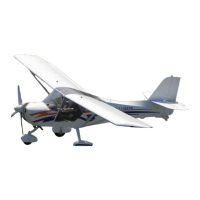34
3.2.6 Descent, Gliding
- airspeed 110 km/h
- throttle increased idle
- wing flaps retracted
- engine instruments values within permitted limits
CAUTION
At long final and when descending from a considerable height, it is not
advisable to reduce the engine throttle control to minimum. In such
case the engine becomes undercooled and a loss of power occurs.
When descending, apply increased idle so that engine instrument
readings range within the limits for normal use.
gliding ratio ......................................................... 1 : 14
optimum gliding speed ................................ 100 km/h IAS
sinking ................................................................ 2.3 m/s
3.2.7 Emergency Landings
Recommended procedures for various types of emergency landing.
3.2.7.1 Precautionary Landing
- choose landing area, evaluate wind direction and speed, area surface,
surrounding obstacles and total safety of the manoeuvre under consideration
- perform approach and fly-over at a speed of 95 km/h along the deliberate area
at a height of 50 m to estimate the area condition, obstacles and to determine
magnetic course of landing
- make orbiting approach to land
- perform landing from the very beginning of the chosen are
a
3.2.7.2 Blown-Out Tyre Landing
- carry out normal approach-to-land
- when floating at landing, keep the damaged wheel above ground as long as
possible using ailerons
- maintain the direction at landing run, applying foot control
3.2.7.3 Damaged Landing Gear Landing
-carry out a normal approach-to-land
-if the nose wheel is damaged, perform a touch-down on main wheels and hold
the aircraft on wheels as long as possible till the speed is lost
-if the main landing gear is damaged, perform touch-down at the lowest speed
possible and maintain direction at landing run, if possible

